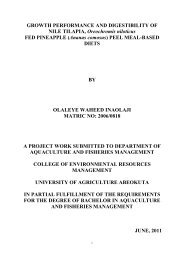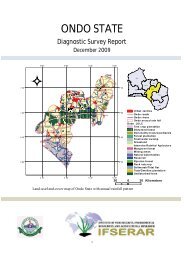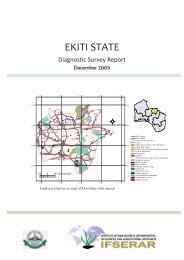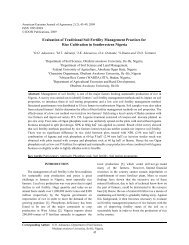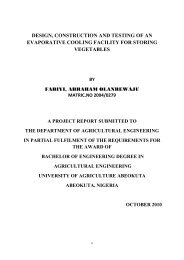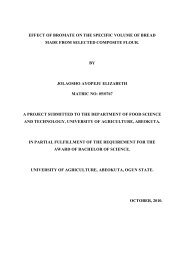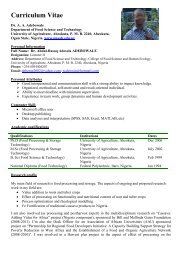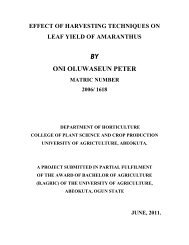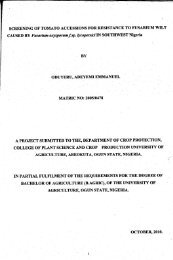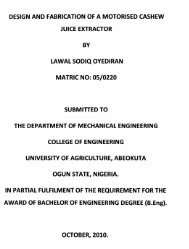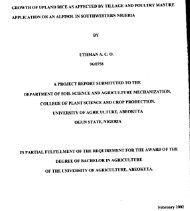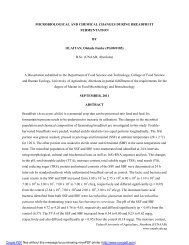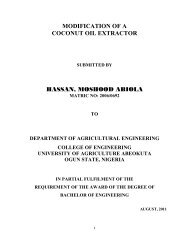akinsanya, olawale - The Federal University of Agriculture, Abeokuta
akinsanya, olawale - The Federal University of Agriculture, Abeokuta
akinsanya, olawale - The Federal University of Agriculture, Abeokuta
Create successful ePaper yourself
Turn your PDF publications into a flip-book with our unique Google optimized e-Paper software.
CHAPTER<br />
FIVE<br />
DISCUSSION<br />
<strong>The</strong> differences observed in particle size distribution according to the levels <strong>of</strong> degradation (Table 1)<br />
were due to selective erosion <strong>of</strong> soil particles by run<strong>of</strong>f. <strong>The</strong> severely degraded site had lost most <strong>of</strong><br />
its fine particles while these were still retained more on the fairly and moderately degraded strips.<br />
<strong>The</strong> texture <strong>of</strong> ~oil, derived from the particle size distribution, determines the potential ability <strong>of</strong> a soil<br />
to influence crop performance. According to Wild (1993), sandy soils are light and low in nutrient<br />
holding capacity. Ross (1989) stated further that sandy soils are porous and highly vulnerable to<br />
leaching and run-<strong>of</strong>f. Thus, sandy soils are infertile and make fertilizer use inefficient. <strong>The</strong><br />
implication <strong>of</strong> this is that more expenditure in terms <strong>of</strong> agricultural inputs will be required to<br />
rehabilitate a degraded site. <strong>The</strong> coefficients <strong>of</strong> variation for particle size distribution showed that<br />
fine particles (silt + clay) would play a critical role in response <strong>of</strong> these soils to management<br />
practices as they varied more than sand. More variation was observed under WAS varieties<br />
compared with ITA varieties, suggesting that varieties might have influenced changes in particle size<br />
distribution through differences in canopy coverage <strong>of</strong> the ground.<br />
Tropical upland soils are inherently low in soil organic matter with usually less than 50 glkg<br />
(David et ai, 1993). <strong>The</strong> low values <strong>of</strong> organic matter (Table 1) suggested that the soil, which was<br />
inherenijy low in soil organic matter, was depleted more at various levels <strong>of</strong> degradation, with the<br />
trend observed from the fairly degraded to the severely degraded strips. Soil extractable P varies<br />
widely in soils <strong>of</strong> the tropics because <strong>of</strong> the capacity <strong>of</strong> tropical soils to fix P and varying capacity <strong>of</strong><br />
.crops for P (Sanchez et aI., 1983). <strong>The</strong> variation in P contents at the various levels <strong>of</strong> degradation<br />
can be attributed to differences in particle size distribution, particularly the high variations in fine<br />
particles (Tables 1 and 2), and variation in nutrient uptake <strong>of</strong> the rice varieties.<br />
30



